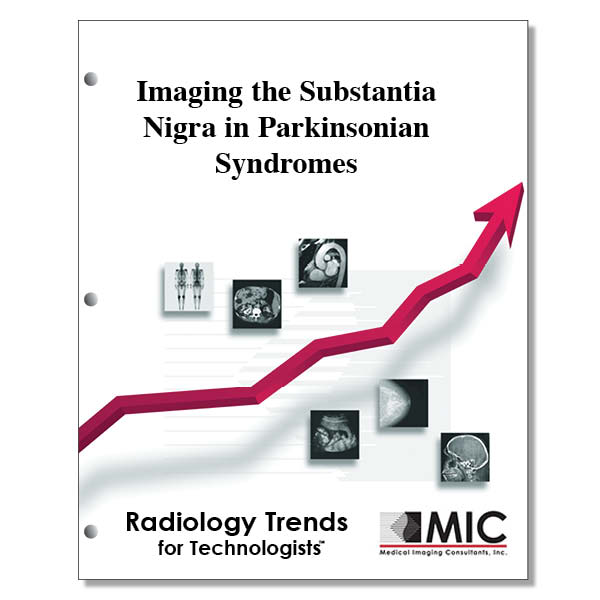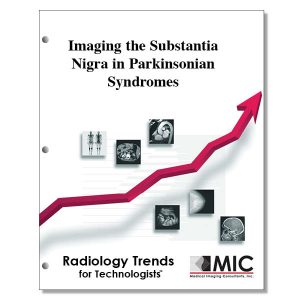

Imaging the Substantia Nigra in Parkinsonian Syndromes
A review of recent developments in nigral imaging for Parkinson disease and other parkinsonian syndromes. Various advanced neuroimaging techniques have provided markers for the nigral structure to enhance diagnosis, differentiation, and subtyping.
Course ID: Q00788 Category: Radiology Trends for Technologists Modalities: MRI, Nuclear Medicine, RRA2.75 |
Satisfaction Guarantee |
$29.00
- Targeted CE
- Outline
- Objectives
Targeted CE per ARRT’s Discipline, Category, and Subcategory classification:
[Note: Discipline-specific Targeted CE credits may be less than the total Category A credits approved for this course.]
Magnetic Resonance Imaging: 2.75
Image Production: 0.75
Data Acquisition, Processing, and Storage: 0.75
Procedures: 2.00
Neurological: 2.00
Nuclear Medicine Technology: 0.25
Procedures: 0.25
Other Imaging Procedures: 0.25
Registered Radiologist Assistant: 2.00
Procedures: 2.00
Neurological, Vascular, and Lymphatic Sections: 2.00
Outline
- Introduction
- Literature Search
- Nigrosome Imaging
- Nigrosome Imaging in PD
- Nigrosome and Dopamine Transporter Imaging
- Nigrosome Imaging in Other Parkinsonian Syndromes
- Technical Improvements in Nigrosome Imaging
- Imaging of Nigrosomes 2-5
- NM Imaging
- NM-Sensitive MRI in PD
- NM-Sensitive MRI and Dopamine Transporter Imaging
- NM-Sensitive MRI in Other Parkinsonian Syndromes
- Deep Learning Application in NM-Sensitive MRI
- Quantitive Iron Mapping
- Relaxometry in PD
- QSM in PD
- Quantitative Iron Mapping in Other Parkinsonian Syndromes
- Future Use of Quantitative Iron Mapping
- Diffusion-Tensor Imaging
- DTI in PD
- DTI and Dopamine Transporter Imaging
- DTI in Other Parkinsonian Syndromes
- Volumetry
- Volumetry in PD
- Volumetry and Nonmotor Symptoms in PD
- Volumetry in Other Parkinsonian Syndromes
- Conclusion
Objectives
Upon completion of this course, students will:
- identify the neurotransmitter systems implicated in the development of nonmotor symptoms in Parkinson’s disease
- be familiar with the use of MRI to differentiate PD from Parkinsonian syndromes
- identify the nigrosome with the greatest depletion of dopaminergic cells in PD
- understand the correlation between RBD and loss of nigral hyperintensity
- be familiar with the risk of relying solely on MRI for diagnoses of nigrostriatal function
- be familiar with 3-T SWI for differentiating drug-induced parkinsonism from idiopathic PD
- recognize that in PSP or MSA-P there is a loss of nigral hyperintensity on 7-T gradient recalled echo imaging
- recognize the limitations of diagnosing DLB with nigral intensity alone
- be familiar with the advantages of employing QSM for nigrosome imaging
- be familiar with the sensitivity and specificity reported by Schwarz et al for detecting nigral hyperintensity loss
- understand the progression of hyperintensity loss in PD from nigrosome 1 to nigrosome 4
- be familiar with the predominate location of NM in the brain
- be familiar with the correlation between the volume of NM-sensitive areas in the SN and the disease duration in PD
- be familiar with the correlations between scoring methodologies and affects of the various domains of the function in the brain in PD patients
- identify the deposits being displayed in figure 8 of the article
- be familiar with the reduction in NM signal in the brain reported in patients with RBD
- be familiar with the reported hypointense signals in the SN pars compacta found in PD patients
- be familiar with the relationship of NM-sensitive MRI and 123I-FP-CIT SPECT in PD assessment
- be familiar with the reported findings of NM-sensitive MRI with nigrosome 1 imaging in the SN for ET prediction
- be familiar with the key findings of Ohtsuka et al in differentiating PD and Parkinson-plus syndromes
- be familiar with the contributions of NM-sensitive MRI to the characterization of Parkinsonian syndromes such as DLB
- recognize the segmentation techniques employed to assess the NM-positive SN pars compacta
- be familiar with the element predominately stored as ferritin in the brain
- identify the sequences on MRI scans affected by iron, enabling quantitative iron mapping
- be familiar with the correlation between iron content and disease severity in PD based on MRI parameters
- be familiar with QSM effectiveness in PD diagnosis
- be familiar with he advantages of QSM in comparison to T2* and R2* relaxometry maps
- identify the areas of the brain that demonstrate an increase in susceptibility values in late-stage PD
- be familiar with significant differences observed in whole-brain voxel-based analysis in patients with ET
- be familiar with DTI measures in tissue
- identify the common measurements feasible with DTI
- be familiar with the FA and MD measurements found in PD patients
- be familiar with the use of DTI to distinguish PD from other parkinsonian syndromes
- be familiar with the reported cognitive impairments among PD patients base on brain atrophy
- identify the reported areas of significant volume loss reported in patients with PSP
